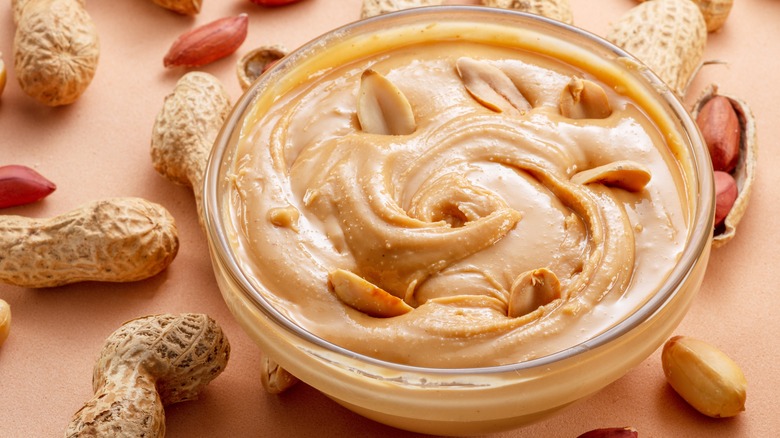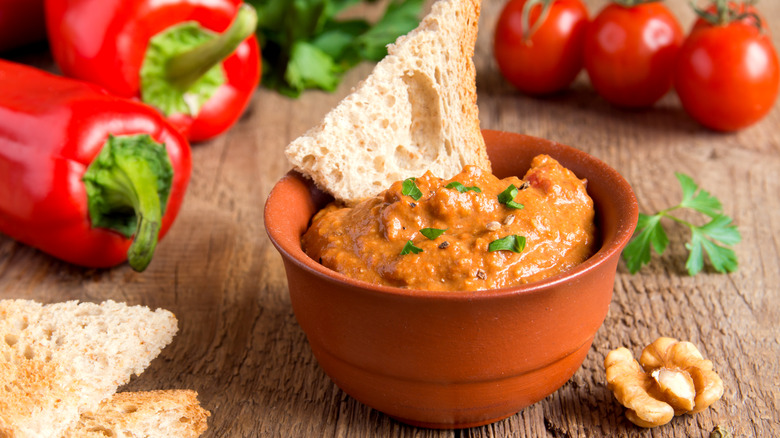Add Your Favorite Nut Butter To Salsa For A Beautifully Creamy Twist
If there's one issue with salsa, it's how watery it tends to be. An overly runny salsa does little texturally for the palate and doesn't have the richness that many dips boast. Unlike other sauces, salsa often lacks fat, which helps provide creaminess. While some dips and sauces use yogurt, avocado, heavy cream, or other high-fat ingredients to provide richness, salsa doesn't feature the same components. To solve this dilemma, try mixing salsa with an unexpected creamy ingredient: nut butter.
One of the most common nut butters on the market is peanut butter. Peanuts pair great with salsa and are already included in versions of recipes like salsa macha, especially in variations with a smoky chili base. When it comes to creamy vs. crunchy, a majority of people prefer creamy peanut butter. The rich mouthfeel and texture make this variety so sought after, and it's that same creamy component that can help upgrade salsa. Nut butter's high-fat content makes it so creamy, an element that most salsas lack. While creamy, nut butters are also mild enough to let the salsa's existing flavor shine.
What salsas to combine with nut butter
When considering if a salsa could use a nut butter upgrade, the type of salsa matters. While both mild and spicy salsa can benefit from a creamy addition, spicy salsa is where nut butters truly shine. The high-fat content in nut butters makes them great at mellowing the heat, just like how milk is commonly recommended to cool mouths after too much spice. Where nut butters have a leg up compared to other creamy ingredients is the way they pair well with savory, spicy flavor profiles like in a peanut soup or satay sauce. This is opposed to thickeners like mayo, sour cream, and yogurt, which tend to work better for sweeter, more uniform sauces because of their consistency and sourness.
The types of salsa that can be combined with nut butter are blended rather than chunky ones with chopped ingredients. Blending combines nut butter with salsa, but it would cause salsas like pico de gallo to completely lose their identity. Charred salsa verde, avocado salsa, and chile de arbol salsa are all sufficiently blended to serve as great candidates for a nut butter inclusion. Both store-bought and homemade salsas work for blending with nut butter, since the salsa can be fully prepared before mixing in this creamy ingredient. It isn't just nut butters that work for salsa, but also seed butters with their similarly creamy texture and nutty flavor.
Tips and ideas for making salsa with nut or seed butter
While peanut butter is the most common, there are many types of nut and seed butters to consider using. Regardless of what you choose, when combining nut butters with salsa in the food processor, a 1:4 ratio of nut butter to salsa should do the trick. If this ratio brings too much of a nutty flavor, consider trying a mellower option. Cashew butter is great for a milder yet still-creamy salsa addition and pairs well with acidic notes in salsas with lime and tomato. Hazelnut butter's richness makes it perfect for a creamy mole-like salsa. The sweet notes of hazelnut also work great with blended fruit or avocado salsas.
Pumpkin seeds are an often overlooked but delicious option that's not uncommon to see in Mexican cuisine. Pumpkin seeds have been a component of the Central American diet since pre-Hispanic times, used in salsas, snacks, salads, soups, drinks, and moles. With this in mind, consider using pumpkin seed butter for a creamy addition to salsa. Even tahini — made from ground sesame seeds — which pairs well with spicy notes, is an excellent choice when making salsa with a fiery kick. Tahini also pairs well with spices like cumin and coriander, often used in Mexican cuisine.


